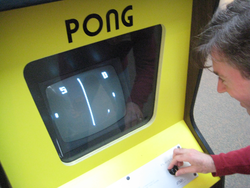Discussed in this post:
- Pong, Al Alcorn, Atari, Arcade coin-op, 1972.
- Pong, Harold Lee, Alan Alcorn and Bob Brown, Atari, dedicated home TV game, 1975.
- Video Olympics, Joe Decuir, Atari, Atari VCS, 1977.
- Pong: The Next Level, Supersonic Software Ltd., Sony PlayStation, 1999.
- Boundish, Nintendo, Nintendo Game Boy Advance, 2006.
It wasn’t the first video game, or even the first arcade game, but that’s like sort of like saying the Model T wasn’t the first car. Pong looms large in both arcade and home video game history. The cabinet and the home unit helped pave the way for economically successful video games, the basic game form was changed and reinvented in numerous ways, and Pong became part of the zeitgeist. Recently, the movie rights to Pong have even been optioned by Uwe Boll.
 Pong‘s design and engineering, its relationship to earlier games, and its launch can be discussed in very great detail, and they have been in many books and various digital forms, from FAQ to page to site. In our book Racing the Beam: The Atari Video Computer System, Ian Bogost and I briefly describe how Pong blasted into the arcade video game space that Bushnell’s Computer Space had attempted to open up:
Pong‘s design and engineering, its relationship to earlier games, and its launch can be discussed in very great detail, and they have been in many books and various digital forms, from FAQ to page to site. In our book Racing the Beam: The Atari Video Computer System, Ian Bogost and I briefly describe how Pong blasted into the arcade video game space that Bushnell’s Computer Space had attempted to open up:
The first Pong unit was installed in Andy Capp’s Tavern, a bar in Sunnyvale, California. Increasingly apocryphal stories of the game’s installation report lines out the door but almost never mention the precedent for coin-operated video games in Andy Capp’s. When Alcorn installed Pong in the summer of 1972, Computer Space was sitting there in the bar already.
Pong solved the problem that plagued Computer Space—ease of use—partly by being based on the familiar game table tennis and partly thanks to the simplicity of its gameplay instructions. “Avoid missing ball for high score” was a single sentence clear enough to encourage pick-up play, but vague enough to create the partial reinforcement of the slot machine and the midway; after failing, players wanted to try again. One other important sentence appeared on the machine: “Insert coin.”
In this post, I’ll mention a few things that I think made Pong appealing to tavern game players in the early 1970s. Then, I’ll look to how a handful of the many Pong remakes over the years have tried to refashion the game for new settings.
This is a preview of
Pong Resonant
.
Read the full post.






 Pong‘s design and engineering, its relationship to earlier games, and its launch can be discussed in very great detail, and they have been in many books and various digital forms, from
Pong‘s design and engineering, its relationship to earlier games, and its launch can be discussed in very great detail, and they have been in many books and various digital forms, from 

 Flame War: A Cyberthriller
Flame War: A Cyberthriller